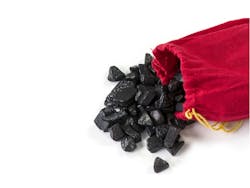Bad news. Santa’s bringing coal this year. How do we change the story?
Bad news. Santa is bringing coal this year. Lots of it. The International Energy Agency (IEA) expects coal-fired generation to reach a new worldwide record high by the end of 2021. This, of course, is the opposite of what supporters of microgrids want to see. The goal is a cleaner, not dirtier, electric system.
So how did we get here?
IEA blames the post-pandemic economic recovery. Demand for electricity is rising quickly and there are not enough clean energy sources to make up the difference. So more coal is being used.
Overall, coal use for power generation is up 9% for an all-time global peak of 10,350 TWh.
Need “strong and immediate” action
China, already the source of half the world’s coal-fired generation, and India, will set all-time highs. The US and Europe will see an almost 20% rise — still keeping them below an earlier record, but significant nonetheless.
“Coal is the single largest source of global carbon emissions, and this year’s historically high level of coal power generation is a worrying sign of how far off-track the world is in its efforts to put emissions into decline toward net zero,” said Fatih Birol, IEA executive director. “Without strong and immediate actions by governments to tackle coal emissions — in a way that is fair, affordable and secure for those affected — we will have little chance, if any at all, of limiting global warming to 1.5° C.”
Not building back better?
Unfortunately, “strong and immediate” government action appears elusive in the US — at least at this writing — following Sen. Joe Manchin’s, R-WV, announcement this week that he will not support President Joe Biden’s Build Back Better bill. Manchin, who represents coal country, holds the pivotal vote in deciding the fate of the legislation, which includes $555 billion in climate spending.
Microgrids are a lynchpin technology in the climate fight and Build Back Better opens up a way to make them more affordable. The bill provides an array of clean energy boosters, including a 30% investment tax credit for microgrids. If microgrids follow the pattern of solar, the tax credit would turbocharge installations. The solar industry has grown 10,000% since its tax credit was enacted in 2006, according to the Solar Energy Industry Association (SEIA).
Yet, even with such massive growth, solar accounts for only 2.3% of US electric generation.
So how do we push more renewable energy into the system so that next time the US sees a spike in electricity demand, coal doesn’t see a corresponding spike?
Pro renewable energy policy helps, but it only goes so far. The mechanics of renewable energy production require a rethinking of how we manage power because wind and solar produce energy on a different schedule than conventional fossil-fuel driven or nuclear power plants.
Emerging grid
The emerging grid requires a new level of software intelligence and flexibility. That’s why microgrids — the most intelligent form of distributed energy — are the lynchpin. When the wind stops blowing or the sun stops shining, microgrids can quickly interject power onto the grid.
Balancing the grid in this way represents one of the services microgrids provide to help create a cleaner, more efficient grid when they are not providing another of their key services: power supply when the grid is down.
Alone, these abilities — grid-strengthening services and energy reliability — make microgrids crucial to creating a grid that can depend less and less on coal-fired generation.
But there is also another major benefit of microgrids, one that we discuss in a vision paper recently released by Think Microgrid, an affiliate of Microgrid Knowledge. Generally small and easy to situate, microgrids can be built right now. This sets microgrids apart from large wind, solar and hydro projects that may require construction of long distance transmission lines to send their energy to population centers — a process that can take decades.
Because they are built close to those they serve, microgrids also bring a new level of efficiency to the grid. Electricity dissipates when it travels long distances over wires. No such “line loss” exists with microgrids.
So, apologies for the gloomy news about the coal for your stocking this Christmas and the microgrid tax credit seemingly on the ropes. It’s not all bad. As 2021 has shown us, the US microgrid industry is on the rise. If you peruse Microgrid Knowledge’s 2021 coverage, you’ll find investment is flowing into the sector, new projects are ramping up, pro-microgrid policies are advancing, and more and more businesses, institutions and even residences are adopting the technology.
Survey shows Americans favor microgrids
Seventy-nine percent of Americans now favor increasing use of microgrids in our electric grid, up from 67% last year, according to a recent survey by Lake Research Partners, the Civil Society Institute and VJBreglio. Layla Zaidane, president and CEO of the Millennial Action Project, described microgrids “as a once in a generation solution.”
Indeed, IEA sees this year’s rise in coal as “a blip” in the US and Europe, where net-zero efforts will drive down its use long term. (Asia may be another story — see IEA’s Coal 2021 report.)
Meanwhile, Guidehouse forecasts that, in the US alone, renewable microgrid capacity will grow from 4,668 MW in 2021 to 32,750 MW in 2032. And with that growth will come jobs — 3.4 skilled jobs for every $1 million invested in renewable microgrids and $500,000 in additional economic benefits.
Coal may have won the day in 2021, but microgrids are the technology on the rise.
Interested in microgrids? Join us for Microgrid 2022: Microgrids as Climate Heroes, June 1-2, 2022, in Philadelphia, Pennsylvania. Registration is now open at early bird discounts.
About the Author
Elisa Wood
Editor-in-Chief
Elisa Wood is the editor and founder of EnergyChangemakers.com. She is co-founder and former editor of Microgrid Knowledge.
